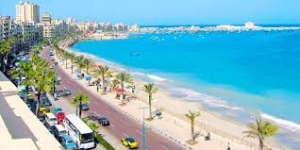Alexandria ,the second capital of Egypt
Alexandria, often referred to as the “Pearl of the Mediterranean,” and it is famous for its rich history and cultural heritage also is considered as the second capital of Egypt with many special attractions:
Attractions of Alexandria:
1. The Corniche: A scenic waterfront promenade stretching along the Mediterranean, perfect for leisurely walks with stunning sea views.
2. Montaza Palace: A royal palace surrounded by lush gardens and overlooking the sea, offering a glimpse into Egypt’s royal past.
3. Bibliotheca Alexandrina: A modern library and cultural center that pays homage to the ancient Library of Alexandria. It also features museums, art galleries, and a planetarium.
4.Qaitbay Citadel: A 15th-century fortress built on the site of the ancient Lighthouse of Alexandria, one of the Seven Wonders of the Ancient World.
5.Alexandria National Museum: Showcasing artifacts from Alexandria’s rich history, including Pharaonic, Greek, Roman, and Islamic periods.
Climate of Alexandria:
Alexandria enjoys a Mediterranean climate, characterized by mild, wet winters and hot, dry summers.
– Winter: Temperatures range from 10°C to 20°C (50°F to 68°F), with occasional rain showers.
– Summer: Temperatures can reach up to 30°C to 35°C (86°F to 95°F), but coastal breezes help to moderate the heat.
Economy of Alexandria:
Alexandria is a vital economic hub in Egypt, with its economy driven by several key sectors:
1. Port Activities: Alexandria’s port is one of the largest and busiest in Egypt, handling a significant portion of the country’s imports and exports.
2.Industry: The city is home to various industries, including petrochemicals, textiles, food processing, and maritime services.
3. Tourism: Alexandria’s rich history and cultural attractions draw tourists from around the world, boosting the local economy.
4. Education and Research: The presence of several universities and research institutions contributes to Alexandria’s economic landscape.
Main Sites of Alexandria:
1. Pompey’s Pillar: An ancient Roman triumphal column, one of the largest of its kind, standing in the remnants of the Serapeum.
2. Catacombs of Kom El Shoqafa: A historical archaeological site featuring a blend of Egyptian, Greek, and Roman cultural elements.
3. Roman Amphitheatre: An ancient Roman theatre that showcases Alexandria’s rich Greek and Roman heritage.
4. Cavafy Museum: Dedicated to the famous Greek poet Constantine P. Cavafy, who lived in Alexandria.
5. Alexandria Opera House: A cultural landmark offering a variety of performances, including opera, ballet, and concerts.
History of Alexandria:
Founded by Alexander the Great in 331 BC, Alexandria quickly became a major center of Hellenistic civilization. It was renowned for:
1. The Library of Alexandria: One of the largest and most significant libraries of the ancient world, attracting scholars from various fields.
2. The Lighthouse of Alexandria (Pharos): One of the Seven Wonders of the Ancient World, guiding sailors safely into the busy harbor.
3. Ptolemaic Period: Alexandria thrived under the Ptolemaic dynasty, becoming a center of learning and culture.
4. Roman and Byzantine Rule: The city continued to flourish during these periods, although it faced several challenges, including earthquakes and invasions.
5. Islamic time:Alexandria fell to the Arab forces in 641 AD, marking the beginning of Islamic rule. The city remained an important port and center of commerce.
6. Modern Era: During the 19th and 20th centuries, Alexandria saw significant development under the rule of Muhammad Ali Pasha and subsequent leaders, becoming a cosmopolitan city with a mix of cultures and communities.
Alexandria today is a vibrant metropolis that seamlessly blends its ancient heritage with modern developments, making it a unique and fascinating destination.
If you interested one day to visit this amazing city check this link here for more details and organized full tours to it.
Written by ATW Updated July 2024







